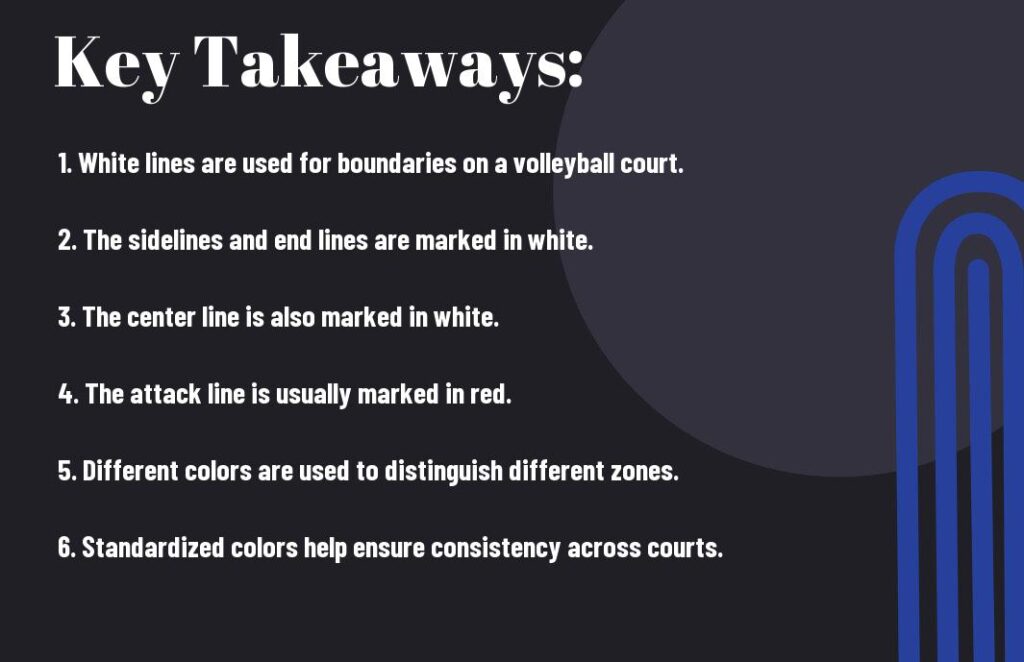When you step onto a volleyball court, the vibrant colors of the court lines may catch your eye. These lines are not only there for aesthetic purposes, but they also serve a crucial role in defining the boundaries of the game. The standard colors used for volleyball court lines are bright, contrasting hues that make it easier for players and referees to see the lines clearly during games. In this blog post, we’ll explore the specific colors commonly used for volleyball court lines and the reasoning behind their selection.
What colors are typically used for volleyball court color?
Have you ever wondered about the specific colors used for the lines on a volleyball court? When it comes to the boundaries of a volleyball court, the lines are typically drawn in two primary colors: white and yellow. These colors are chosen for their high visibility and contrast against the floor surface, making it easier for players and officials to see and determine whether the ball is in or out of bounds. Understanding the significance of these colors is essential for maintaining the integrity and fairness of the game.
Key Takeaways:
- Standard colors: The typical colors used for volleyball court lines are white for the boundary lines and the attack line, and yellow for the center line.
- Regulation guidelines: These color choices are based on the regulations set by the International Volleyball Federation (FIVB) and other governing bodies to ensure consistency and uniformity across volleyball courts worldwide.
- Visibility and contrast: The use of white and yellow lines provides good visibility and contrast against the playing surface, making it easier for players, officials, and spectators to distinguish the different court boundaries and markings.
Key Takeaways:
- Standard colors: Volleyball court lines are typically colored in white to provide high visibility and contrast against the playing surface.
- Consistency: The color of court lines is standardized to ensure uniformity across different volleyball courts and competitions.
- Regulatory requirements: The use of specific colors for volleyball court lines is governed by the rules and regulations set by governing bodies such as the FIVB (Fédération Internationale de Volleyball).


Traditional Volleyball Court Line Colors
Any volleyball player knows that the court lines are an essential part of the game, providing boundaries and marking important zones. The colors used for these lines are not chosen at random, but are carefully selected to provide clear visibility and contrast against the playing surface. Understanding the traditional volleyball court colour is important for both players and organizers, as it ensures a consistent and professional standard across different competitions and venues.
Standard Colors across Different Associations
When it comes to the standard colors used for volleyball court lines, there is a high level of consistency across different associations and organizations. The main colors used are white for the boundary lines and yellow for the attack lines. These colors are chosen for their high visibility against different playing surfaces, making it easy for players, officials, and spectators to clearly see the court boundaries and key zones.
Psychological Impact of Traditional Volleyball Court Line Colors
The traditional colors of volleyball court lines not only serve a practical purpose but can also have a psychological impact on players. The use of contrasting colors such as white and yellow can help players easily distinguish the court lines and stay focused on the game without being distracted by ambiguous or blending colors. Additionally, the use of high-contrast colors can subconsciously signal to players and spectators that the court is well-maintained, professional, and suited for competitive play.
Understanding Color Usage in Volleyball
One of the most crucial aspects of setting up a volleyball court is the proper use of colors for the court lines. The color contrast is essential for players to distinguish the boundaries and effectively navigate the court during play. Understanding color usage in volleyball is important not only for the players but also for the officials and spectators.
Common Colors for General Play Lines
When it comes to the general play lines on a volleyball court, the most commonly used colors are white and yellow. White lines are typically used for the boundary lines of the court, including the sidelines and end lines. These lines are essential for determining if the ball is in or out of play. On the other hand, yellow lines are often used for the centerline and attack lines. The contrast between these colors is crucial for players to quickly assess the court and make split-second decisions during the game.
Use of Color in Competitive Volleyball Court Lines
In competitive volleyball, the use of color for court lines is even more critical. The lines need to be clearly visible and easily distinguishable to ensure that no errors are made during play. In addition to the standard white and yellow lines, some competitive courts also incorporate other colors, such as blue or red, for specific designated areas. These areas may include the substitution zones and the libero replacement zone. The use of different colors for these areas helps to avoid confusion and ensures that the game is played fairly and accurately.
Variations in Volleyball Court Line Colors
To ensure the proper functionality of a volleyball court, you need to understand the standard and variations in volleyball court line colors. The colors of the court lines can vary depending on various factors such as indoor or outdoor usage, professional leagues, and personal preferences. For more information on volleyball court lines, you can visit Winning Edge Sports.
Influence of Indoor vs Outdoor Volleyball Court Line colors
When it comes to indoor volleyball courts, the standard colors for the boundary lines are typically white or a light color that contrasts the primary color of the floor. On the other hand, outdoor volleyball courts tend to utilize brighter, more vibrant colors for court lines, such as yellow or orange, to ensure visibility in various lighting conditions. It’s important to understand the influence of indoor versus outdoor court line colors to optimize your playing experience and performance.
Deviations in Court Line Colors in Professional Leagues
In professional volleyball leagues, there may be deviations from the standard court line colors based on league regulations or sponsorships. Some professional leagues may feature court line colors that align with their branding or specific event themes. It’s important to stay informed about these deviations to ensure you are familiar with the court line colors you may encounter in professional settings. The adaptability to different court line colors can give you a competitive edge in various playing environments.
Impact of Color Choices on Visibility and Player Perception
Despite the fact that volleyball court lines are generally painted in standard colors, the choices made can have a significant impact on visibility and player perception. The colors used for the lines can directly affect how easily players can see and track the ball, as well as how they perceive the movement and boundaries of the court.
Visibility Factors for Volleyball Court Line Colors
When considering the visibility of volleyball court line colors, it’s important to take into account the contrast between the lines and the playing surface. High-contrast colors such as white, yellow, or light blue tend to stand out more against a darker surface, making it easier for you to track the ball and identify the court boundaries. On the other hand, low-contrast colors like light green or light orange may blend in too much with the playing surface, leading to decreased visibility and potential confusion during play. Assume that visibility is crucial for quick decision-making and player safety.
Player Perception of Different Court Line Colors
Player perception is another crucial aspect to consider when choosing volleyball court line colors. The colors used for the lines can influence how you perceive the size and shape of the court, as well as the speed and trajectory of the ball. Bright, vibrant colors such as neon yellow or bright blue can create a sense of energy and dynamism, enhancing your perception of the playing environment. Conversely, dull, muted colors like pale gray or beige may have a dulling effect on your perception, making the court seem less dynamic and engaging.
Regulation of Volleyball Court Line Colors
However, when it comes to the colors used for volleyball court lines, there are specific regulations that must be followed to ensure consistency and fairness in the game. The standard colors for volleyball court lines are white for boundary lines and red for attack lines, center lines, and the top of the net. These regulations are set in place to maintain clarity and visibility during the game.
Role of Associations in Defining Court Line Colors
Various volleyball associations, such as the FIVB (International Volleyball Federation) and USA Volleyball, have set standards for court line colors to be followed in official competitions. These associations play a key role in defining and enforcing the regulations to ensure that all volleyball courts maintain consistency in line colors. By adhering to these standards, you can be confident that you are playing in a fair and regulated environment.
Implications of Non-Standard Court Line Colors
Using non-standard court line colors can have serious implications for the game. Inconsistent line colors can lead to confusion among players, referees, and spectators, ultimately impacting the fairness and integrity of the game. It can also create safety hazards as it may affect the visibility of the lines, resulting in potential errors in gameplay. It is important to recognize the potential consequences of using non-standard court line colors and ensure that you are playing on a court that meets the regulations set by the relevant volleyball associations.
Regulations and Guidelines for Volleyball Court Line Colors
Now that you know the importance of choosing the right colors for volleyball court lines, it’s essential to understand the regulations and guidelines that govern these choices. By following these rules, you can ensure that your court is not only visually appealing but also safe and compliant with standard regulations. In this chapter, we will delve into the specific guidelines and regulations set for volleyball court line colors.
National and International Standards
When it comes to the color of volleyball court lines, there are specific standards set by both national and international governing bodies. According to these standards, the main court boundary lines should be marked in a contrasting color to the surrounding floor or ground, such as white or yellow. This helps improve visibility and ensures that players and referees can easily distinguish the court boundaries during gameplay. It’s important to adhere to these standards to maintain a level playing field and minimize the risk of errors during the game.
Non-standard or Unusual Court Line Colors
While there are strict guidelines for the standard colors used for volleyball court lines, there are instances where non-standard or unusual court line colors may be used. However, it’s crucial to exercise caution when deviating from the standard colors, as doing so can lead to confusion among players and officials. If you are considering using non-standard colors for your volleyball court lines, it’s important to consult with the relevant governing bodies to ensure that your choices are in line with the regulations and do not pose any safety or fairness concerns.
Conclusion
Now that you understand the typical colors used for volleyball court lines, you can ensure that your local court is properly marked for your next game. Remember, the standard colors are white for the boundary lines and clear, contrasting lines for the court markers. For more information on beach volleyball court lines and other sport equipment, visit Sport Equipment – Beach Volleyball – Court Lines.
Case Examples
Lastly, let’s take a look at some case examples of volleyball court line colors to give you a better idea of what is typically used in different settings.
Olympic Volleyball Court Line Colors
When it comes to Olympic volleyball courts, the standard colors used for the lines are typically strong and contrasting, such as bold black lines on a bright, vivid background. This high contrast allows for easy visibility for both players and spectators, ensuring that the game can be played and enjoyed without any confusion or uncertainty. The use of bold and vivid color combinations helps to emphasize the importance of the game and creates a visually striking court for this prestigious event.
Beach Volleyball Court Line Colors
For beach volleyball courts, a slightly different approach is taken when it comes to line colors. The natural and relaxed setting of beach volleyball often calls for softer, more natural colors to blend in with the surroundings. For this reason, beach volleyball court lines are often painted in more muted tones, such as light blue or yellow, which complement the sand and sea backdrop without overwhelming the eye. The use of subtle and natural color choices allows for a more harmonious blend with the environment, creating a picturesque setting for this popular beach sport.
FAQ
What colors are typically used for volleyball court lines?
Volleyball court lines are typically white. The outer boundary lines, as well as the lines marking the attack line, center line, and volleyball service lines, are all typically painted in a solid white color. This provides a clear contrast against the court surface, making it easier for players, referees, and spectators to see and understand the court layout.
Are there any regulations regarding the color of volleyball court lines?
Yes, according to the official rules set by the Federation Internationale de Volleyball (FIVB), the governing body for international volleyball competitions, the lines on a volleyball court must be a solid, contrasting color to the playing surface. White is the most commonly used color for court lines, but other solid, contrasting colors may be used as long as they meet visibility requirements and do not cause confusion for players or officials.
Are there any variations in the color of volleyball court lines for indoor vs. outdoor play?
Generally, the color of volleyball court lines remains the same for both indoor and outdoor play. However, for outdoor courts, especially those with non-traditional playing surfaces such as sand or grass, the lines may be painted in a color that provides the best contrast and visibility against the playing surface. In such cases, white or other contrasting colors may be used to ensure that the court lines are clearly visible to all participants.
Conclusion
Now that you know, the colors typically used for volleyball court lines include white for the boundary lines and various other colors for the attack lines. The distinct color contrast helps players and referees clearly see the court lines, which in turn contributes to the fair and accurate playing of the game. By understanding the standard colors used for volleyball court lines, you can ensure that your court is properly marked and ready for competitive play.



